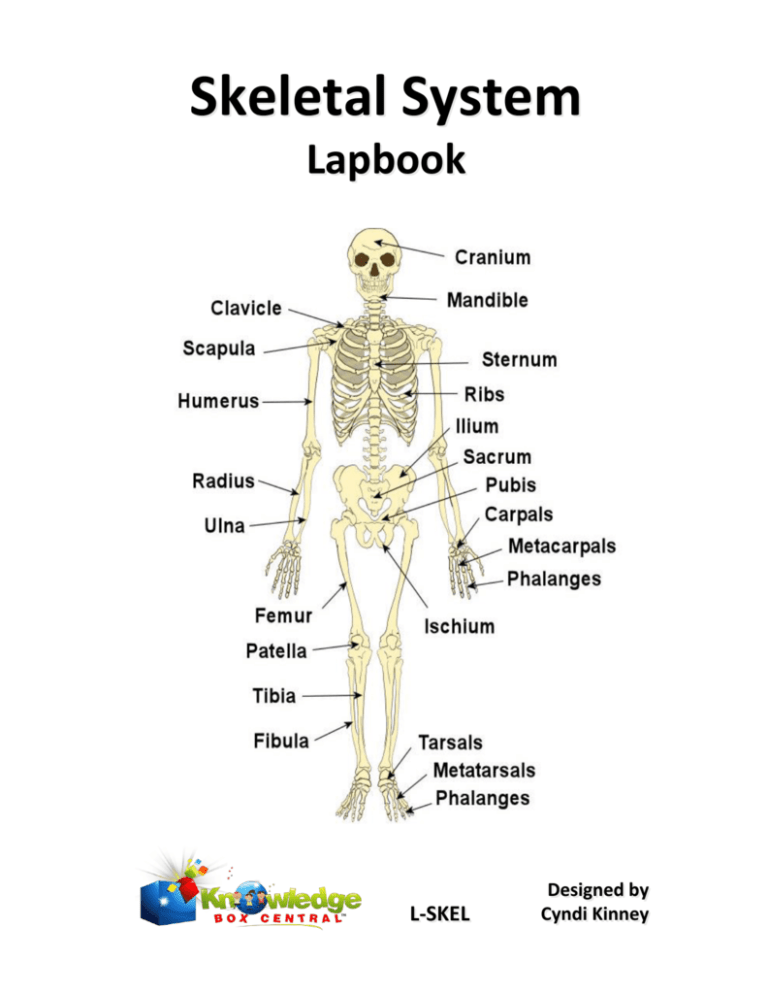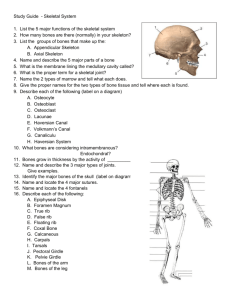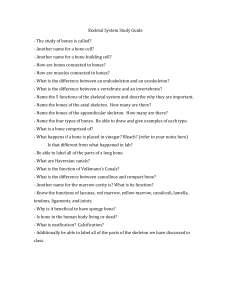
Skeletal System
Lapbook
L-SKEL
Designed by
Cyndi Kinney
Skeletal System Lapbook
Copyright © 2013 Knowledge Box Central
www.KnowledgeBoxCentral.com
ISBN #
Ebook:
CD:
Printed:
Assembled:
978-1-62472-038-3
978-1-62472-036-9
978-1-62472-037-6
978-1-62472-039-0
Publisher: Knowledge Box Central
http://www.knowledgeboxcentral.com
All rights reserved. No part of this publication may be reproduced, stored in a retrieval
system or transmitted in any form by any means, electronic, mechanical, photocopy,
recording or otherwise, without the prior permission of the publisher, except as provided by
USA copyright law.
The purchaser of the eBook or CD is licensed to copy this information for use with the
immediate family members only. If you are interested in copying for a larger group, please
contact the publisher.
Printed or Assembled formats are not to be copied and are consumable. They are designed
for one student only.
All information and graphics within this product are originals or have been used with
permission from its owners, and credit has been given when appropriate. These include, but
are not limited to the following: www.iclipart.com, Art Explosion Clipart,
www.homes.bio.psu.edu, www.fi.edu, www.nlm.nih.gov, and www.etc.usf.edu.
Special thanks to Carrie Martin-Vegue. She is the author of the Study Guide that is included
in this product. The Study Guide is being used with her permission and is now owned by
Knowledge Box Central.
How do I get started?
First, you will want to gather your supplies.
*** Assembly:
*Folders: We use colored file folders, which can be found at Walmart,
Sam’s, Office Depot, Costco, etc. You will need between 1 and 4 file folders,
depending on which product you have purchased. You may use manila folders if
you prefer, but we have found that children respond better with the brightly
colored folders. Don’t worry about the tabs….they aren’t important. Within this
product, you will be given easy, step-by-step instructions for how to fold and
assemble these folders. If you prefer, you can purchase the assembled lapbook
bases from our website.
*Glue: For the folder assembly, we use hot glue. For booklet
assembly, we use glue sticks and sometimes hot glue, depending on
the specific booklet. We have found that bottle glue stays wet for too
long, so it’s not a great choice for lapbooking. For gluing the folders together, we
suggest using hot glue, but ONLY with adult supervision.
These things get SUPER hot, and can cause SEVERE
burns within seconds.
*Other Supplies: Of course, you will need scissors.
Many booklets require additional supplies. Some of these
include metal brad fasteners, paper clips, ribbon, yarn, staples, hole puncher, etc.
You may want to add decorations of your own, including stickers,
buttons, coloring pages, cut-out clipart, etc. Sometimes, we even
use scrapbooking supplies. The most important
thing is to use your imagination! Make it your own!!
Ok. I’ve gathered the supplies. Now how do I use this
product?
Inside, you will find several sections. They are as follows:
1. Layout and Pictures: This section gives instructions and diagrams that will
tell the student exactly how to assemble the lapbook base and where to glue
each booklet into the base. Depending on the student’s age, he or she may
need assistance with this process, especially if you choose to allow the student
to use hot glue.
2. Student Instruction Guide: This section is written directly to the student,
in language that he or she can understand. However, depending on the age of
the child, there may be some parent/teacher assistance needed. This section
will also tell the student exactly what should be written inside each booklet as
he or she comes to it during the study, as well as telling the student which
folder each booklet will be glued into.
3. Booklet Templates: This section includes ALL of the templates for the
booklets. These have been printed on colors that will help to improve retention
of the information presented, according to scientific research on color
psychology.
Skeletal System Lapbook
Layout & Pictures
You will need 3 folders of any color. For each folder, you will fold both sides
toward the original middle fold and make firm creases on these folds (Figure 1).
Then glue the folders together along one flap (Figure 2).
Figure 1
Figure 2
Number of Bones
This is the “Layout” for your lapbook. The shapes are not exact on the layout, but you will
get the idea of where each booklet should go inside your lapbook.
Hemopoisis
Long
Bones
Skeletal
System
Purpose
Fun Fact
Axial
Skeleton
Folder 1
Bone
Categories
Appendicular
Skeleton
Fun Fact
Leg
Bones
Wrists and
Ankles
Thoracic Cage
Folder 2
Arm
Bones
Synovial Joints
Crossword
Name as many
bones as you can.
Vertebral
Column
Skull
Osteoblast
Word
Search
Osteocyte
Label the Skeleton
Osteoclast
Fun Fact
Folder 3
Below is a picture of a completed
lapbook!!! This should help in figuring
out how to assemble the booklets and
then how to put it all together!
Folder 1
Folder 2
Folder 3
Skeletal System Lapbook
Student Instruction Guide
Booklet 1: How Many Bones?
Assembly Instructions: Cut out along the outer black line edges of this one-page booklet.
Glue to another piece of paper of a different color. Trim around the edges to create a small
border.
Completion Instructions: Tell how many bones a baby is born with, and then tell how
many bones an adult has.
Booklet 2:
Skeletal System Purpose
Assembly Instructions: Cut out along the outer black line edges of each page. Stack so
that the title is on the top and the pages get longer toward the back. Secure at the top with
staples or metal brad fasteners.
Completion Instructions: Your skeletal system has many purposes. Tell about each one
inside this booklet.
Booklet 3:
Hemopoiesis
Assembly Instructions: Cut out along the outer black line edges of the booklet. Fold
along the center line so that the title is on the front.
Completion Instructions: Inside this booklet, explain hemopoiesis.
Booklet 4: Bone Categories
Assembly Instructions: Cut out along the outer black line edges of each page. Stack so
that the title is on top and the tabs on the pages get longer toward the back. Secure along
the left side with staples of metal brad fasteners.
Completion Instructions: There are five different types of bones. Tell about each one
inside the booklet.
Number
Of
Bones
Babies:
Adults:
Booklet #1
Skeletal
System
Purpose
Support
Protection
Movement
Booklet #2
Storage
Hormone
Booklet #2
The Skeletal System
Lapbook
Teacher’s/Study Guide
Introduction
Bones are fascinating things. Think about it. What would you look like without
your bones? You would be a shapeless blob. Your skull supports your face and
gives you your unique look. Your spine helps you to stand straight and tall. Your
leg and arm bones allow you to move, walk and run.
Imagine life for a moment with your skeletal system. Pretty creepy, isn’t it?
When a baby is born, he has over 270 bones. As he grows and matures some of
these bones fuse together so that by the time he is an adult there are only 206 bones
in his body.
https://homes.bio.psu.edu/faculty/strauss/anatomy/skel/skeletal.htm
Your skeletal system has many purposes. The first is support. The bones in your
body support your body’s entire weight. Think about that for a moment. Your
bones have to be made strong enough to be able to support the entire weight of
your body!
Your bones also provide protection. What protects your brain from being
damaged? Your skull. What protects your heart and lungs? Your thoracic cage.
Your skeletal system is also responsible for all of the movement you are able to do.
The point at which two bones meet is a joint. And that joint allows you to move
your fingers, toes, arms, and legs.
Your bones also store calcium, iron and fat in the form of yellow bone marrow.
And finally your bones play a part in the endocrine system of your body by
producing a hormone that helps to regulate your blood sugar and fat deposits
throughout your body.
http://www.fi.edu/learn/heart/blood/red.html
Hemopoiesis
Hemopoiesis is the production of red blood cells. Your bones are responsible for
the production of the red blood cells that carry oxygen to the cells throughout your
entire body.
The larger bones in your body are hollow and that hollow space is filled with red
bone marrow. The red bone marrow is what actually produce the red blood cells
and white blood cells, which are involved in your immune system and help your
body to fight off illnesses.
Bone Categories
There are actually five different types of bone.
Long bones are ones that are longer than they are wide. They are weight-bearing
bones. The growth in these bones is controlled by the endocrine system. The
anterior pituitary gland secretes a hormone called the growth hormone that causes
the long bones to grow.
Short bones are as long as they are wide. Their main job is to provide support and
stability for your body.
Flat bones are thin and curved.
Sesamoid bones are small and round. Sesamoid bones are found with tendons
because one of their jobs is to protect its tendon. It works to hold the tendon away
from the joint and works to give the tendon as much mobility as possible. (Your
kneecap is a good example of a sesamoid bone.)
Irregular bones are ones that don’t fit into one of the four above categories.
http://www.nlm.nih.gov/medlineplus/ency/imagepages/9582.htm
Long Bones – Epiphysis
The epiphysis of a long bone is found at both ends. It’s the rounded portion at
either end of the bone. The epiphysis is made from cancellous bone, which is also
known as spongy bone. It looks similar to a lattice work with lots of little holes. In
those holes is the red bone marrow.
Long Bones – Diaphysis
The diaphysis is the long portion of the bone. It is made up of compact bone,
which is extremely dense.
Long Bones – Epiphyseal Plate
The epiphyseal plate is found between the epiphysis and the diaphysis. In a child it
is made up of hyaline cartilage.








